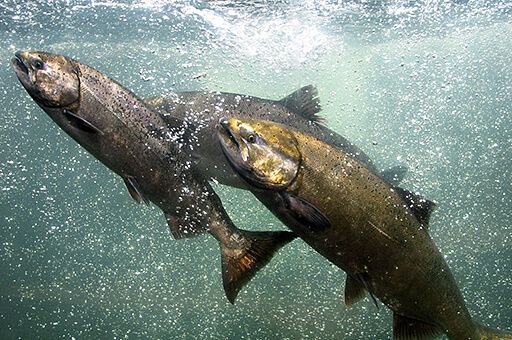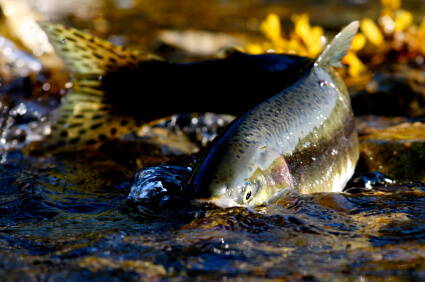By Todd Manley
The State of California has recently made significant investments in Sacramento Valley salmon recovery under voter-approved Propositions 68 and 1. The California Natural Resources Agency recently announced the investment of almost $50 million in Proposition 68 funding for projects to promote salmon recovery. More than $220 million in Proposition 1 and Proposition 68 funds have also been dedicated for multi-benefit flood protection projects in the past two years that will benefit salmon. Most of this investment will support projects located in the Sacramento Valley. These projects will advance objectives contained in the California Natural Resources Agency’s Sacramento Valley Salmon Resiliency Strategy and the National Marine Fisheries Service’s Central Valley Chinook Salmon Recovery Plan.
Importantly, these projects are located in the upper reaches of rivers to provide vital Chinook salmon spawning and rearing habitat, in the middle reaches to promote juvenile salmon outmigration by removing barriers and in the lower reaches where they reactivate floodplains to provide food and shelter for those same out-migrating juvenile fish.

Spawning and Rearing Gravel
Placement of gravel to create beds and side channels in the upper river below rim dams provides critical habitat for salmon to spawn and for juvenile fish to rear and feed as they prepare for the lengthy migration downstream to the ocean.
Feather River Gravel Augmentation
The project will result in the installation of 8,000 cubic yards of much-needed gravel to improve spawning habitat at key riffles in the lower Feather River.
Hallwood Project (Phase 1)
This wide-ranging project to improve habitat in the Yuba river for juvenile Chinook salmon includes the development of floodplain rearing habitat, creation of side-channels, riparian habitat, instream habitat and cover complexity.
American River Gravel Augmentation Projects
These two gravel projects will improve substrate conditions for spawning and rearing Chinook salmon at key riffles in the lower American River. This will result in improved spawning habitat, river morphology, floodplain habitat, riparian habitat and instream cover and habitat complexity.

Fish Passage
Along the migratory corridor in the middle river, salmon recovery work is focused on projects that remove barriers to fish passage, such as installing fish screens on diversions. These projects provide additional benefits, including diversions in winter months to provide Pacific Flyway habitat, participate in the fish food program, or other benefits, without concerns of entraining or otherwise harming winter-run Chinook and other species of concern.
Screening Meridian Farms Water Company’s diversion will complete one of the last two high-priority fish screen projects on the Sacramento River. This is helping to fulfil a multi-decade effort that has now resulted in more than 95 percent of the water being diverted from the Sacramento River through screened diversions to protect salmon. This project will also place Meridian Farms Water Company’s diversion in a deeper part of the river, which will allow for increased flexibility in managing water levels along the Sacramento River, particularly during dry years, which can help serve multiple benefits, including the recent focus on ensuring cold water pool retention in Shasta Lake for incubating salmon.

Floodplain Reactivation
These floodplain reactivation projects will provide food, rearing habitat and protection from predators to juvenile Chinook salmon as they migrate downstream on their way out to the ocean. This helps to fill a much-needed gap in habitat and food that over the past several decades has been missing. Floodplain reactivation includes both “wet-side” projects that occur in between levees along waterways and in the region’s bypasses and “dry-side” projects that produce Fish Food on Floodplain Farm Fields while also benefitting birds and other species.
The state is also investing in complementary multibenefit systemwide flood protection projects across the Central Valley. Over $220 million in Proposition 1 and Proposition 68 funds have been dedicated for these purposes in the past two years.
Landscape Scale Multi-Benefit Floodplain Feasibility Study
This study is the first attempt to investigate the combination of options at multiple weirs and gated outlet structures that are part of the flood control system in the Sacramento Valley to determine their ability to be operated in a coordinated manner to maximize floodplain habitat for more than 100,000 acres in the region. The study will also include the development of new modeling to evaluate the options as part of the effort to develop a master plan for the system.
Wet Side
Willow Bend
The Willow Bend project reconnects 87 acres of floodplain to the middle portion of the Sacramento River, creating ideal rearing habitat for out-migrating juvenile Chinook salmon and other fish species. The project will also include landscape improvements to reduce stranding of juvenile fish utilizing the habitat.
Tisdale Weir Rehab and Fish Passage
This funding will help to complete the project to improve Tisdale Weir to resolve a longstanding fish stranding problem when water recedes behind the Tisdale Weir after a flood event. The project will benefit multiple species of fish including the protected winter-run and spring-run Chinook salmon and green sturgeon. This funding augments additional state investments of multibenefit flood funding to rehabilitate the weir and to advance a study of the potential to create floodplain habitat for juvenile salmon by more frequently inundating the Tisdale Bypass.
Dry Side
Fish Food Pilot Program
This funding will further advance the multi-year pilot program to optimize growing food for salmon in winter-flooded rice fields that is drained back into the river at the most effective times to feed juvenile salmon as they migrate downstream on their journey to the ocean. This unique effort is a collaboration of landowners, water management entities, academic institutes and fish and bird conservation organizations. This is described in more detail in Fish Food on Floodplain Farm Fields.

Complementary Project Funding
Several of these projects have also received federal investments and are part of state and federal partnership efforts to promote salmon recovery in the region. These projects will join the recently-announced Central Valley Improvement Act (CVPIA) funded projects that will be implemented through approximately $40 million in grants awarded to Glenn-Colusa Irrigation District, Reclamation District 108, River Partners and Chico State Enterprises.
As salmon recovery work continues in the Sacramento Valley, additional funding from Proposition 68 and other state sources, as well as CVPIA and additional federal appropriations will join local funding and resources to implement these much-needed projects.
For more information on Sacramento Valley salmon recovery efforts, please see https://norcalwater.org/efficient-water-management/salmon/ or email me at tmanley@norcalwater.org.



